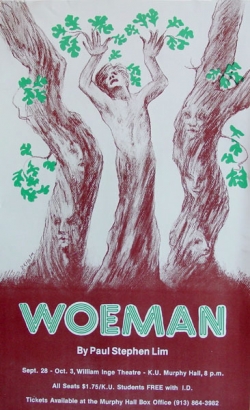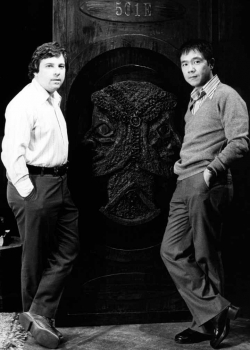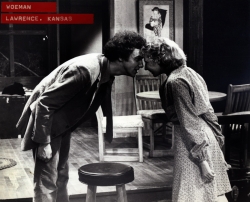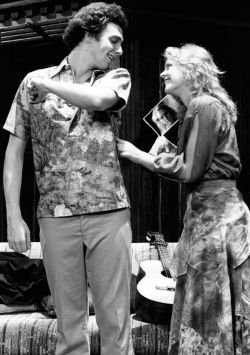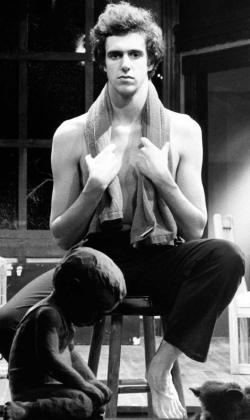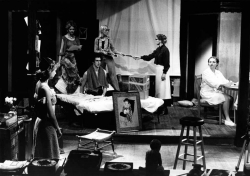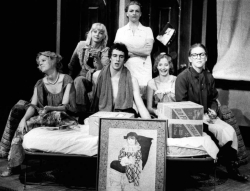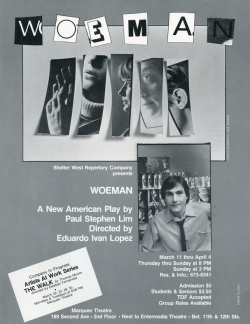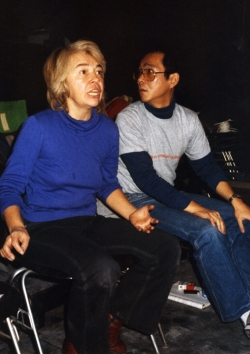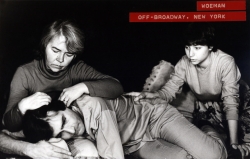Woeman: A Recreation in Two Acts
Images from the Show
Overview
Requirements: 5F, 1M
Setting: A small studio apartment in an old building near Columbia University, New York City. Saturday afternoon, late June, the present.
Plot: Something has happened to Charlie Womack, a photo-journalist in his mid-30s. All we know is that he is in the hospital, and that his mother has called an impromptu meeting in Charlie’s apartment. Arriving at different intervals are Luette, Charlie’s 15-year-old daughter; Hildaberta, a German exchange student who lives in the same apartment building and who has been having an affair with Chairlie; Edgarda, Charlie’s ex-mistress, an older woman who continues to pay his bills; Geraldine, Charlie’s beautiful ex-wife and Luette’s mother; and, of course, Matilda, Charlie’s formidable mother, a registered nurse in her mid-50s. Charlie himself appears only in flashbacks, as each of these women share painful stories about their respective relationships with Charlie. The final image in the play is that of Charlie sitting on his bed in a catatonic state, as the five women strip his apartment, taking things that belong to them or that they might have given to Charlie in happier times.
Theme: Thresholds of physical and psychological pain, and how much a man can endure before he snaps. The conceit was to write a play about five important women in the life of one man, and how each of these women appeals to one of his five senses. The man is “complete” as a human being only when all five women are in seeming harmony in his life. What would happen to such a man if these women were to withhold or withdraw their support suddenly, in quick succession, within a 24-hour period? Would such a man be reduced to catatonia?
Notes: Sometime in 1977, two students at the University of Kansas told me stories about themselves which stayed with me, stories which would not go away until I put them down on paper. One story was told in excruciating detail by Steven Johnson, at an evening gathering, about a car accident he had been in, in which his right hand was nearly severed, but reattached (badly) by surgeons through a series of operations. He showed us his hand, how he could not move his fingers separately. Move one finger, and all the other fingers move simultaneously, “as though waving goodbye.” I asked Steve if he would tell the story again the following day so I could tape it. He did, and his story appears almost verbatim in Woeman. The other story was told by another young man, at another evening gathering. His name was David Moses. He was very drunk, so I have no idea if the story he told was in veritas or not, about what his father did to him when he was still a child, when his parents were undergoing a particularly nasty divorce. I did not ask David to repeat his story on tape, and I have taken some liberties with the details as the story is told in Woeman. Through the years, I hear occasionally from Steven Johnson, and he fills me in on various female celebrities he claims he has been sleeping with in New York and Los Angeles. As for David Moses, he went to Boston after he graduated from K.U. Last I heard, he had died of A.I.D.S….More inventively, Woeman also has built-in echoes of the tragic story of Dryas from Greek mythology. As for the the title of the play, again it is a made-up word. Most obviously, it implies that the play is about a man who is full of woe. More subliminally, I wanted to suggest a variation, perhaps a more ancient spelling, of the plural form of “woman.” And finally, although I wrote the lyrics for the song “Trees” which is sung by the character Geraldine in the play, the haunting music was composed by Craig Swanson. Craig also posed for the figure of the man in the poster. The painting is by Lawrence painter Dennis Helm, who subsequently also died of A.I.D.S.
History: The play was first produced in the William Inge Theatre at the University of Kansas, Sept. 28-Oct. 3, 1978. Jack Wright was the director, and Del Unruh designed the set. Rusty Laushman played Charlie Womack. The women were played by Joan Oberndorf, Deborah Moke, Heather Laird, Kathleen Warfel and Diana Sinclair. The production was entered for competition in the original scripts division of the Kennedy Center American College Theatre Festival. During the feedback session, the KCACTF respondent (I forget her name) said that she “hates plays with flashbacks,” so we knew immediately that, unlike Conpersonas, neither the play nor the production was going to advance to the next stage of the competition. Woeman was subsequently produced Off-Broadway in New York at the Marquee Second Story Theatre by Judith Joseph’s Shelter West Company in March of 1981. It was directed by Eduardo Ivan Lopez. Anthony Di Novi played Charlie Womack. The women were played by Mary Charalambakis, Kevin Madden, Sandra Soehngen, Christy Brotherton, and Judith Joseph herself played Charlie’s mother.
Sampling of reviews:
“Lim’s play is rich in resonances, allusions and symbols. His sensitivity and imagination show a literary intelligence.” — Glen Loney, After Dark
“A psychological who-dun-it….The playwright cleverly and successfully weaves the informative flashbacks…into the present.” –Joanne Pottlitzer, Other Stages
“Lim has written characters of substance, depth and complexity….An emotionally exhausting study of the impact of divorce and the inevitable failure of human relationships….Riveting….A human drama that aims for the gut.” — John Bush Jones, The Kansas City Star
“Lim has a gift for both urbane and cruel dialogue….His new play…ends with an impact that leaves the audience gasping.” — Mary Davidson, Lawrence Journal-World
Availability: From Aran Press, and also from the author.


